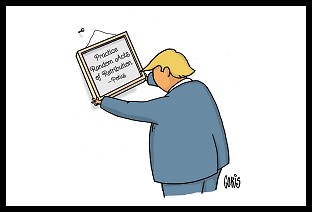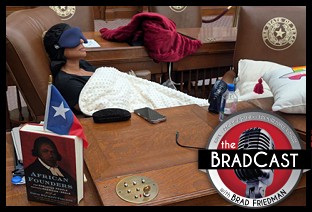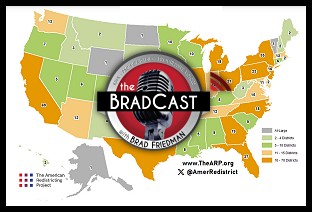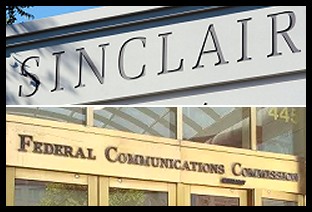READER COMMENTS ON
"EXCLUSIVE: ES&S TOUCH-SCREEN VOTING SYSTEMS FOUND VULNERABLE TO 'SERIOUS' VIRAL VOTE-FLIPPING ATTACK; U.S. ELECTION ASSISTANCE COMMISSION REFUSES TO ISSUE WARNING"
(66 Responses so far...)
COMMENT #1 [Permalink]
...
TomaHawk
said on 4/16/2007 @ 9:50 am PT...
I would hope that copies of these e-mails have been forwarded to Rep. John Conyers.
COMMENT #2 [Permalink]
...
Ancient
said on 4/16/2007 @ 11:06 am PT...
And just what will Senator Feinstein who should be investigated for war profiteering do about all this.......hmmmmmmm?
GIVE ME A REASON TO FORGIVE YOU SENATOR!
BAN DRE'S NOW and NEVER ALLOW ANOTHER WHITE HOUSE TO APPOINT EAC MEMBERS
and maybe all's you'll have to do is pay a small part of your fortune back!
COMMENT #3 [Permalink]
...
youngharry
said on 4/16/2007 @ 11:37 am PT...
It is time to hold our elected officials accountable for our elections and appoint an Independent Prosecutor to investigate the voting machines and their makers.
Either we have a voting system that reflects correctly each vote cast or we don't. If we don't have such a system, then we no longer have a democracy. It's as simple as that.
The Republican Congress gave us the HAVA system, which has proved to be corruptible in favor of the Republican owners of our voting machines and the Republican Appointees also control those that have oversight on the safety and sanctity of the machines and our vote.
The only conclusion that can be drawn is that the system we have and those that control it are nothing more than anti-democractic criminals that want to ensure the Republican Party stays in control of this country by any and every means possible.
Call your Congressman and Senators and demand a Special Prosecutor NOW!!!
COMMENT #4 [Permalink]
...
Bev Harris
said on 4/16/2007 @ 12:25 pm PT...
Electronic Voting: The gift that keeps on taking
The truth about the Holt Bill (HR 811): A "Clear and Present Danger"
The Holt Bill, HR 811, is on the "fast track." It has over 200 sponsors who apparently didn't read the small print:
... oh by the way this bill permanently funds putting elections under the control of four White House appointees. (The EAC)
This structural change will alter forever the checks and balances and that hold this nation together.
What they're not telling people is that this particular effort to give us a paper trail also requires us to give control over elections to the White House.
Wait a minute, why should we? What does one have to do with the other?
We need to split the paper ballot requirement – which we all agree we want – away from sticking elections under the control of the White House. Oh, and while we're at it, can we dump the DREs, once and for all? The Holt Bill is back on the table and Congress is back in session. The bill still tries to permanently fund presidential control. Take action accordingly.
What's this about presidential appointees?
This problem started with another misguided piece of legislation, the "Help America Vote Act" (HAVA, which we call "Help Themselves to America's Vote Act.").
HAVA pushed electronic voting into place all over the U.S. and set up the "Election Assistance Commission" (run by four presidential appointees) to oversee all the spending.
But the EAC decided to do a lot more than write checks. One of the very first acts the EAC did in July 2004 was to try to set up the cancellation of elections in case of crisis situations. Think about this for one moment: What good is a paper ballot if they can cancel elections???
The EAC was supposed to be disbanded in 2005, but now the Holt Bill – in exchange for paper trails --- is quietly trying to put presidential appointees in permanent control of elections. This structural change in the checks and balances of our great nation is dangerous. Unless this is corrected, we need to "Halt Holt."
The EAC seems to think that being a "clearinghouse" means clearing the way for more technocrap.
The EAC seems to think "oversee" means "overlook".
Can someone please get these crooks a dictionary?
But listen --- even if the current batch of EAC people WAS doing a good job, putting the EAC under the Executive Branch is a crazy idea. It's a dealbreaker for the Holt Bill.
All it takes is one rogue president to bring the election system to ruin under the EAC, and as for doing "better congressional oversight" --- all it takes is one rigged election to gum up congressional oversight.
There are many ways to solve this problem. Make the oversight body a 50-state representational body. Put it under NIST, which is a representational body. Put the EAC under the legislative branch instead of the White House. But never ever pass a bill that makes you give up control to the White House in exchange for a paper trail.
And while we're at it, at what point are we going to do a real investigation of these crooks?
COMMENT #5 [Permalink]
...
allie
said on 4/16/2007 @ 1:06 pm PT...
I think all parties involved in this should be charged with "obstruction of justice" if they fail to communicate these findings to every state. Time is of the essence right now to find alternatives for 08 or it will be futile for anyone to vote at this point. The faith of the american people in our voting system has been shattered; it's time to no longer fool ourselves about this intentionally flawed system to allow for convenient and probable hacking of our votes. We suspect that it was done in 2000 and we know that it was done in 2004 (indictments in Ohio). We cannot sit back and do nothing when we now have prima facie evidence of a very serious problem of vulnerability and lack of safety of our constitutional right to vote.
COMMENT #6 [Permalink]
...
brantl
said on 4/16/2007 @ 1:40 pm PT...
I think starting now, would be good. Conyers needs to embarass them out of this bill.
COMMENT #7 [Permalink]
...
Dredd
said on 4/16/2007 @ 4:41 pm PT...
Bev #4
You are being a bit incorrect to equate "White House control" with presidential nominations. They are not equal.
Our government has been doing "this" since the ink used to write the constitution first dried.
The "this" is the president nominates but the congress validates ... or not.
This president understands the or not and perverts the system by "recess appointments" like Bolton. But Bolton is gone.
The EAC is like countless other entities composed of presidential nominees confirmed or not ("advice and consent" ... or not) of the Senate.
Lets be precise.
After all the movement wherein you currently have (and should) preeminence is 40 years old and still not really respected.
I mean, Dugger it and NIST it and Dylan it ... it all comes out the same ... yadda yadda yadda all these decades. Some how we are still where we have always been.
The Supreme Court is "not under the Executive" just because the president can nominate Justices. Neither is the EAC simply because the president can nominate its members.
Remember Bork? He got "borked" not rubber stamped.
The real solution (in my current opinion) is a direct verification election each two years. We need a constitutional amendment that requires a vote of the people, without any consideration of the Electoral College, each two years to validate a presidency.
If a majority of the people vote "no confidence" in a president, then we call a presidential election in the next election cycle.
We need to improve our election system by adding an element of democracy to replace that representive aspect of our system.
A pure republic is weak, and we need to morph into a hybrid where we are neither pure republic nor pure democracy.
The EAC is not the big issue ... it is only an issue.
Any mature view of US government contains an understanding of how three seperate portions of government ... Article I (Legislative), Article II (Executive), and Article III (Judicial) work together to produce an outcome for the good of the people.
Anything less than including all three is an incomplete picture.
COMMENT #8 [Permalink]
...
EllenB
said on 4/16/2007 @ 5:20 pm PT...
Broward County, FL that uses ES&S software version 8.0.1.2 has not produced audit data, event logs and ballot image logs since April 05. County SOE staff claimed in a recent public records request for the audit logs from Nov. 06, they couldn't produce it because it was not a required election record and therefore it currently does not exist.
COMMENT #9 [Permalink]
...
the_zapkitty
said on 4/16/2007 @ 5:29 pm PT...
Dredd... This is the congress that "validated" a presidential EAC appointment without hearings or debate in the middle of the night so they could get votes for something else.
COMMENT #10 [Permalink]
...
Dan
said on 4/16/2007 @ 5:32 pm PT...
Dredd,
You make some very very good points.
But the movement most successful in the past 2 decades, is the Christian Conservative movement. The have control of the RNC, and the RNC now controls the Whitehouse, who, in turn is attempting to take control of the Judiciary. (successfully using the recess appointment to this advantage)
There exists evidence that the RNC has successfully gamed at least 2 of the past National Election cycles, and the politicization of the Judiciary "appears" to be for the purpose of "weighing" future elections in such ways that would disenfranchise traditional Democratic voters. The staffing within Justice, remember, is now, mostly made up from the rolls of Christian Conservative Law Schools, which were not even accredited a decade ago.
After 9/11, the great motivating event foretold by the PNAC, an RNC controlled congress chose to abdicate their constitutionally assigned duties and relinquished significant new powers to the executive. It was an RNC controlled congress that allowed the executive the expanded war powers and the ability to make permanent recess appointments. At the same time, this same RNC controlled congress has allowed corporate interests to participate in the Bill drafting process and legislative decision making processes. All of which has been neatly funded via Abramoff and the "K" street gang. Many of these same corporate interests funneling money through the "K" street gang are the major contributors to the RNC general fund...just read about MZM and the Cheney Office equipment allocation of 140,000 and the now famous dukestir yacht purchase for 140,000 a mere 2 weeks later.
The implications are this, the likes of Dobson, Robertson, Murdoch and Kristol now control the RNC, and the RNC, via Rove, Cheney, PNAC, Faux News, LA Times et al, controls the white house and has stacked the Judiciary , and the RNC has bought off the Congress.
The RNC is controlled by big money Industry/media/policy people who actually represent about ONLY 25% of the voting public in this nation.
In short, this nation's government has been hijacked by a MINORITY neo fascist movement while our attention was diverted and is now "almsot" fully controlled by a powerful minority who does not seem to care that the interests of it's populace is represented (or not).
While election integrity is only "an" issue, currently it is the "MOST" important issue. If another National Election is gamed, there will be NO WAY to give our congress the political will they NEED in order to rescind the self destructive policies that have been implemented by the corrupted political machines of BOTH the RNC and the DNC.
I have written 3 different times to my republican congress person, Martin Causer, regarding the corruption of the election process and the absolute need for open, verifiable and transparent elections.
Not surprisingly, he does not consider this a pressing issue.
We have no other choice, we must be able to, vote the bums out! This, in IMHO, is our most pressing need to address, right here, right now.
COMMENT #11 [Permalink]
...
Dan
said on 4/16/2007 @ 6:16 pm PT...
Dredd,
I want to address 1 very important point that SHOULD be true...
==================================================
Any mature view of US government contains an understanding of how three seperate portions of government ... Article I (Legislative), Article II (Executive), and Article III (Judicial) work together to produce an outcome for the good of the people.
Anything less than including all three is an incomplete picture.
==================================================
This would be the case, if Congress functioned as the drafters of the constitution had intended. And the direct vote for the House and Senate SHOULD have ensured this check and balance would function correctly.
However, since Congress has been systematically abdicating their responsibilities for several decades, the direct vote for House and Senate representatives no longer functions as it was intended, and the Executive enjoys powers never intended for it.
The ONLY way to correct this new imbalance, is to send a Clear and Concise message to Congress during the 2008 Election Cycle. This congress, in spite of the win in November, has already indicated they lack the political will to impeach, therefore limiting their options, even before any significant dirt digging took place.
As long as we can hold Congress accountable, we can prevent them from further abdicating responsibility, and even ensure congress rescinds legislation that has weakened their constitutionally allocated powers.
Congress is the only branch of US government directly elected. Hold them responsible, and the rest won't matter a whole lot.
COMMENT #12 [Permalink]
...
Badger
said on 4/16/2007 @ 6:32 pm PT...
"Voter Confidence and Increased Accessibility Act" (HR811), as proposed by Rep. Rush Holt, will for the first time remove HAVA's previous 2005 funding "sunset". The act would make the EAC a permanently funded federal body under the control of the White House.
While Presidential appointees are common I think where elections are concerned, in a democratic system, power of appointment over elections belongs to the legislative branch that represents the PEOPLE in government- Congress.
Given the revelations about the DOJ and the attempt to promote voter fraud as a problem- when it clearly is not- yes, there needs to be an investigation all the way back to HAVA and the relationship between Ney and Abramoff.
COMMENT #13 [Permalink]
...
Dan
said on 4/16/2007 @ 6:55 pm PT...
Badger,
I say we take a real close look at Rush Holt and his backing/Funding/Legislation Drafting assistance.
Follow the money, it brought down Ney and Cunnungham, just because Holt has a "D" in front of his congressional designation, it doesn't mean he hasn't been compromised.
At this point, we should trust no one!
COMMENT #14 [Permalink]
...
howdy
said on 4/16/2007 @ 8:08 pm PT...
A computer isn't fully secure and it was "...vulnerable to a very dangerous attack by a single person..."?
Here's the NIST or the NSA or ISO 15408.
There's no such thing as a secure computer. AND there's no such thing as two different "types" of votes. One vote for one contest one vote for another. Ludicrous. Ask the Deputy in KY who ran for Sheriff what he thinks of "equal protection."
All those above links to computer security put people at the head of the list of things to secure and assure. It all starts there. Next comes the ability to show your system either is or isn't compromised. I hope both of those items show up whenever Secretary Bowen gets that testing criteria done. When was that due?
COMMENT #15 [Permalink]
...
Shannon Williford
said on 4/16/2007 @ 8:44 pm PT...
(somewhat OT...)
God bless the family and souls of the victims of today's Virginia Tech tragedy.
Before the current administration was "elected" using flawed voting systems, the gun death crime rate had been coming down; thanks to the Brady Bill, which forced a waiting period and a background check for any who wanted to by pistols.
The newly "elected" administration promptly repealed the Brady Bill and the murder rate has been rising since.
Our hearts go out to the victims.
shw
COMMENT #16 [Permalink]
...
Dredd
said on 4/17/2007 @ 4:47 am PT...
Zapkitty #9, Dan #10-11
The links in post #7 above show that this movement concerning dangers brought to our election systems, via insecure electronic voting machines, goes back 40 years to circa 1964.
Yet we are still here, along with the corrupt electronic voting machines, are we not?
The addressing of fixing what is not broken sometimes seems to be the downfall of the movement.
Group against group, activist against activist while congress is critized for not being "unified" on the issue. 
It will not do to try to fix what is not broken and ignore what is broken.
The foundational problem is psychological, but that is being ignored for the most part.
Americans believe they are the number one country in everything (including "democracy") and that is a long standing state of mind in this nation ... and one that must be considered.
Zapkitty and Bev want to blame congress because an EAC appointment was negligently done or because the president can nominate appointees to the EAC.
But the machines were around for decades before the admittedly negligent failure to hold hearings on that appointee happened. And before this president or the EAC even existed.
That appointee did not cause the machine problems ... it was done before that appointee was even born ... and before the 110th and the 109th congress even existed.
Our psychology is what is broken: "america right or wrong", "america love it exactly as it is or leave it" ... and similar notions plague us.
A fundamental psychological wall is the notion that we do elections right ... period. This delusion will reject any notion that anything is wrong. That is the prevalent sentiment we have to deal with.
So we must answer the question "what problem with our holy elections" not to our own satisfaction, but to the satisfaction of those hypnotized by the blind faith that is a wall between us and fixing the problems.
Our system and structure of government is not the real problem, our blind faith in our national status as the greatest democracy is.
Somehow we must reach a populace that really does not think anything is wrong on the scale that we do.
Bev and Brad and John and the bloggers here are certainly not the problem, they are the hope. I only point out things so we keep going forward and do not slip sideways.
I love the movement and the activism.
COMMENT #17 [Permalink]
...
the_zapkitty
said on 4/17/2007 @ 5:24 pm PT...
Dredd... issuing brand blandishments against treating the symptoms of the disease while offering no plan to cure the disease does the patient no damn good at all.
The bill has been messed up and they are apparently refusing to fix it... so we shouldn't stop it from being made into yet even more bad laws?
Or should we take the power-brokers at their word that HR 811, "Holt II", is all the election reform we'll be graciously allowed by the brokers so we should just shut the fuck up and take what we're given... even if we've learned that the bill will actually screw things up even worse?
Neither Congress nor the big lobbying groups are actually fond of the arrival of the bloggers as a political force... because the bloggers will insist on the officials actually do their job while not offering out the goodies the officials have come to expect from the big lobbying groups as a reward for doing their job.
COMMENT #18 [Permalink]
...
phil
said on 4/17/2007 @ 5:46 pm PT...
These horrible electronic voting machines are the cause of everything bad that is currently happening.
I can't even think of anything else to say to even reply to this thread.
I'll go off topic, does anyone know if the Emergency Alert System got used during the Virginia Tech Murders?
I mean hell, if it wasn't used (And I don't know that's why I asked.) then it ought to be retired permanently.
What good is EAS testing if they are never going to use it?
I forgot, the head of FCC is a Bush appointee and does not care about running power and frequency from a technician standpoint, but from a PROFIT standpoint. And you could tie that back to the ELECTRONIC VOTING MACHINE.
If we want national security, we need a DRAFT, and we need the military to protect the constitution against DOMESTIC constitution destroyers and oath of office breakers. A security clearance cleansing. Surveillance of the leaders to make sure they aren't committing more and more felonies.
COMMENT #19 [Permalink]
...
Grizzly Bear Dancer
said on 4/17/2007 @ 6:13 pm PT...
UNLESS THE ELECTRONIC VOTING SYSTEMS ARE REMOVED AND DESTROYED YOU PEOPLE ARE JUST PISSING IN THE WIND.
YOUR COUNTRY IS RULED BY CORPORATE FASCIST IMPERIALISTS AND WILL CONTINUE TO BE RULED BY THESE GREEDY DESTRUCTORS
UNLESS
YOU TAKE AWAY THEIR ABILITY TO USE AND CONTROL OUR GOVERNMENT.
TAKE AWAY THEIR POWER TO USE MONEY AS A TOOL TO BUY POLITICIANS AND INFLUENCE GOVERNMENT ISSUES AS WELL AS HOW OUR TAX DOLLARS ARE SPENT AND MAYBE..
MAYBE
YOU (AMERICANS) WILL REGAIN SOME INFLUENCE OF YOUR GOVERNMENTAL DECISIONS THAT EFFECT THE US AND THE WORLD. THIS WILL ALSO TAKE REORGANIZATION OF THE US BANKING SYSTEM.
RIGHT NOW ALL YOU CAN DO IS WISH THESE CRIMINALS WHO HOLD ALL THE CARDS AND CARE LESS ABOUT YOUR COLLECTIVE AMERICAN INTERESTS DO THE RIGHT THING.
GOOD KING BAD KING?
NO. JUST A BUNCH OF ANTI-ENVIRONMENTAL PATHETIC HUMANS WHO HAVE MANIPULATED AND INFILTRATED THE SYSTEM OF CHECKS AND BALANCES TO THE POINT THAT IT CANNOT FUNCTION PROPERLY AS IT WAS CREATED BY OUR FOUNDING FATHERS.
RIGHT NOW THEIR MONEY AND GUNS CONTROLS THE SHIT. THIS DID NOT HAPPEN OVERNIGHT. WE MUST REMOVE AND JAIL THESE FASCIST REPUBLICANS AND THEIR FASCIST DEMOCRATIC ENABLERS POSING AS FREEDOM FIGHTERS BECAUSE AS BRAD SAYS, "THIS DEMOCRACY WILL NOT SAVE ITSELF."
DO NOT ACCEPT THE HOLT AMENDMENT.
COMMENT #20 [Permalink]
...
phil
said on 4/17/2007 @ 6:16 pm PT...
then it ought to be retired permanently.
Can I change that to the head of the FCC should be fired?
And new policy to actually allow real news to flow again put in it's place. The forth estate is a joke. Their frequencies ought to be taken over EVERYTIME there is a domestic problem.
I mean what is it for nukes? Like this administration is going to tell us that huh?
COMMENT #21 [Permalink]
...
phil
said on 4/17/2007 @ 6:19 pm PT...
Grizzly,
I am with you man. Didn't mean to bury your thread. Your spot on. This isn't a constitutional republic. Cause there ain't no constitution.
COMMENT #22 [Permalink]
...
Joyce McCloy
said on 4/17/2007 @ 11:14 pm PT...
Why should the EAC pay any more attention to this than the experts did to ES&S' smoothing filter memo?
It took me 5 months before anyone (including computer scientists) would listen to me about the ES&S Smoothing Filter memo.
http://journals.democrat.../WillYourVoteBCounted/39
Now its a big deal.
Yes, the EAC should be doing this, or maybe NIST, but if I recall correctly, the EAC was set up a year before they got funding for an office?
They need better appointees, and we need to lobby our political parties to nominate better people.
The EAC is likely to be around a long while, unless this position defaults to the Atty Gen or to private orgs like Election Center.
There's a new sheriff in town, and the EAC will have some oversight.
These software flaws and virus threats are exactly why its so impt to pass HR 811, so that we can review the source code to begin with. And so that every state has paper, audits and recounts in 08.
COMMENT #23 [Permalink]
...
the_zapkitty
said on 4/18/2007 @ 4:14 am PT...
A true election activist without a doubt... and spewing unthinking "talking points" propaganda right and left.
"The EAC is likely to be around a long while..."
No.
In fact it was already supposed to cease to exist.
Why is it so imortant to you that it stays in business? And I mean why is it so important to you?... We already know why democracy-leeching special interests just love the EAC to death.
"... unless this position defaults to the Atty Gen or to private orgs like Election Center."
More of the scare tactics that spring up like weeds whenever "Holt II" is discussed: Pass it NOW NOW NOW or it'll be far the worse for you! (Come to think of it there could be another word for that... extortion.)
"There's a new sheriff in town, and the EAC will have some oversight."
How quaintly... ignorant. Sorry, but there's no other word for it. I remember these self-same "sheriffs" voting to torture prisoners as long as they weren't American... and they weren't too careful with the wording even then.
Where did the oversight that was in place before go? What will keep the current oversight from going away again? The answer, one the Founding Fathers knew well, was to not rely on excessive piling up of offices on offices to keep greed in check... and to not give the federal government control over everything.
"These software flaws and virus threats are exactly why its so impt to pass HR 811, so that we can review the source code to begin with."
No.
It won't allow that.
Did you not research the bill?
Black Box Voting has a good start http://www.bbvforums.org...91/46591.html?1176203712
You will find out that the bill cannot do what it proposes to do without immediately decertifying every voting machine in existence... not too mention casually legislating into existance technology that doesn't exist yet... and won't for years.
So... the bill will have to be changed because the EVM vendors will not allow themselves to be put out of business. And the bills sponsors have to know that by now... and they refuse to discuss changing it before enactment. In Congress that means that they plan to change it in ways that are not... "socially acceptable" just before passing it. And as sure as the sun rises in the east those changes will "accidentally" remove public oversight of the source code. You won't see a damn thing more than I will. And ACCURATE, in another of their "You're really not helping here" moments, has already issued guidance to the EAC that source code should only be available to "qualified individuals"... "qualified"... want to place a bet on how just qualified you'll have to be when they change that?
Do you get the message already? In case you didn't: You've already been sold down the river along with the rest of us.
"And so that every state has paper, audits and recounts in 08."
I won't even go into that again, that stalking horse have already been thoroughly refuted by Brad and others. Ain't gonna happen. The bill makes much noise about such things while carefully insuring that election officials will never actually have to implement such time-wasting chores as actually counting paper... and math has been presented showing that the audits won't work the way whoever was in charge of that part of the bill thought they would work.
No. "Holt II" needs serious disussion and modification before it gets anywhere near a vote and it seems that Holt just doesn't want to discuss these bothersome little details... at least he seems reluctant to discuss them with anyone that doesn't represent the power- and money- of a traditional big lobbying group.
COMMENT #24 [Permalink]
...
Dredd
said on 4/18/2007 @ 5:37 am PT...
Zapkitty #17
You said:
Dredd... issuing brand blandishments against treating the symptoms of the disease while offering no plan to cure the disease does the patient no damn good at all.
True. But treating the wrong disease (a misinformed diagnosis) is no better of course. And that was my point ... don't fix what is not broken but do fix what is broken.
Fix the electronic voting machines ... not the structure of government ... don't whine about EAC members being nominated by the president and then confirmed or rejected by the Senate. There is nothing ipso facto wrong with that structure. It has been around since the ink on the constitution dried and is not a problem.
You continued:
The bill has been messed up and they are apparently refusing to fix it... so we shouldn't stop it from being made into yet even more bad laws?
It is to early in the legislative process to see if amendments will be offered ... or not allowed. That remains to be seen. I suggest sending emails and making calls to suggest amendments.
COMMENT #25 [Permalink]
...
Dredd
said on 4/18/2007 @ 6:33 am PT...
Zapkitty #9
I was watching the Senate action on TV and the unanimous consent request to approve the EAC nominee without reference to committee, and it did not happen at night.
I did some research for you so you can contemplate House bill HR 811 and its compliment in the Senate S 559.
If you follow the links and study the two bills, you will notice that the two bills are different.
Focusing only on HR 811 is being unaware, because the constitution makes congress bi-cameral.
These two bills will have to morph into a bill agreed to by both the House and the Senate in conference, before being presented to the President for signature or veto.
The Senate has no amendments yet, nor has it held hearings on it yet, according to the record, but the House has held hearings but as of yet records no amendments.
The Senate version has some interesting language:
This bill establishes mandatory security requirements for voting systems used in Federal elections. It also will provide for routine, random audits of paper ballots and make it illegal for a chief State election administration official to take an active part in a political campaign.
(Sen. Nelson's Introduction, emphasis added). The House bill does not have the same characteristics as the Senate bill.
Thus, the issue is still embryonic in some senses. There is still time to address several concerns.
COMMENT #26 [Permalink]
...
the_zapkitty
said on 4/18/2007 @ 11:32 am PT...
Dredd. So wrong... and then you give what amounts to complete abdication of prior arguments by invoking Nelson's s.559...
The EAC does not belong in the electoral process.
The EAC was never designed to be a permament part of the electoral process.
The EAC has failed utterly at every task it was supposed to perform.
Instead the EAC turned into an e-voting machine vendor's lobbyist group... even to point of insisting on telling states that EVM's were required by law when they were not.
And now just because the democratic party was burned by corrupt state-level election officials they want to strip the states of voting regulatory power and give it to... the federal government in the name of the EAC. The same federal government that gave you runaway domestic spying, concentration camps being built again in the USA, a severe lack of Habeus Corpus and so much else we have to be thankful for...
"I did some research for you so"
No you didn't. You failed to even do the amount of research I'd already done.
"the Senate version has some interesting language: This bill establishes mandatory security requirements for voting systems used in Federal elections."
Hint: that's not the language in the bill. That is the senator's sales pitch. It adds no legal qualifications as to what the bill actually does.
"The House bill does not have the same characteristics as the Senate bill."
Wrong... and you haven't read it, have you? I did:
http://www.bbvforums.org...73/46800.html?1173151274
... except for only two changes it is functionally identical to hr. 811. In other words s.559 is "Holt II part 2"
The first change is the omission of 811's "get out of paper recounts free" card... which is admittedly slighly better than hr.811... but it still does not mandate that a paper ballot be counted in the first place if a DRE pseudo-ballot is handy... so what's to recount? Election over and the wrong person is permanently in office regardles of the amount of paper stacked in a back room that says otherwise. Or perhaps the paper will not even say otherwise since DRE "printouts" are not paper ballots and will say whatever the hell the machine wants to say regardless of what the voter actually intended... and regardless of what vote the machine actually cast. See Busby-Billbray for a current real-life example of this principle run amok.
The second change is the addition of the "no secretary of state shall be running a presidential campaign in which he's counting the votes." Admittedly another improvement over hr.811... but s.559 still fails to address the other severe failures of the language that it shares with hr.811...
...such as mandating the immediate decertification of all existing EVM's...
... the requirement for the completely unfeasible disclosure of all source code for all software and firmware in existing EVM's (when a great deal of that code is in the form of private commercial software products whose owners will not turn loose of it come hell or high water)...
... the unfunded mandates for technology that currently doesn't exist and will not exist for years...
... the inability of citizens to actually oversee the election process and the resultant records thereof...
Sorry, Dredd: call it 811 or 559 or 96210 it's still messed up and no one with actual input into the bil seems to want to explain why it stayed messed up despite multiple valid warnings to the contrary... and they sure as hell ain't bothering to explain how they're going to fix what's wrong.
COMMENT #27 [Permalink]
...
phil
said on 4/18/2007 @ 12:38 pm PT...
I been here commenting on the Bradblog for some time now,
I know a few of the regulars here, I hope we can all figure out the right thing to do instead of destroying each other.
We all know the EVM's are fucked up.
HOW can we fix it?
COMMENT #28 [Permalink]
...
the_zapkitty
said on 4/18/2007 @ 1:00 pm PT...
... phil said...
"I been here commenting on the Bradblog for some time now, I know a few of the regulars here, I hope we can all figure out the right thing to do instead of destroying each other."
phil, phil... don't worry... this is not destroying each other. I still exist. Dredd still exists. Our ideas still exist.
...this is just reasonable debate... well, fairly reasonable... Dredd's unreasonably stubborn and I cheat unmercifully when no one is looking... 
But this is actually normal for hammering out conflicting political ideas. They do the same on Capitol Hill all the time... only much less honestly.
"We all know the EVM's are fucked up."
You know that. Dredd knows that. I know that. It's apparently the sponsors behind "Holt II" who seem to be unclear on the concept.
COMMENT #29 [Permalink]
...
Dredd
said on 4/18/2007 @ 1:37 pm PT...
Zapkitty #26
I did not abdicate prior arguments.
You can see what I mean. Reasonable people can differ as to what HR 811 and S 559 say and mean.
However reasonable people cannot differ as to whether or not the two are the same. Only an unreasonable person would say they are the same. And it is an obvious ruse to resort to "functionally identical". Show me where the text is identical and then you will have made your point and I would gladly agree. I like agreement.
When the Senate does not want its own version of a bill it can and often does accept the House bill verbatum. That was done recently, for example, on an Iraq resoulution. When there are two bills you can rest assured that they are not the same.
You can prove your case, since you claim to be the only one between us who has read them  , and point out what is exactly the same and what is not.
, and point out what is exactly the same and what is not.
You have saved us all time by addressing the one issue ... the fact that the Senate version would do away with Ken Blackwell type scenarios ... it would make it illegal to be Secretary of State and Chair of an Election Campaign at the same time.
I consider that to be a big deal since Blackwell was able to corrupt elections but would not have been able to if the Senate language was law. And I salute you for admitting that the House bill does not have that provision. Like I said, they are different.
The perfection demanding tantrum is the spirit that has kept this movement ineffective for some forty years now as I pointed out above where I said:
I mean, Dugger it and NIST it and Dylan it ... it all comes out the same ... yadda yadda yadda all these decades. Some how we are still where we have always been
(Post #7, above). Those who Duggered it would have read a 1988 article which said:
DURING the past quarter of a century, with hardly anyone noticing, the inner workings of democracy have been computerized. All our elections, from mayor to President, are counted locally, in about ten thousand five hundred political jurisdictions, and gradually, since 1964, different kinds of computer-based voting systems have been installed in town after town, city after city, county after county. This year, fifty-five per cent of all votes-seventy-five per cent in the largest jurisdictions-will be counted electronically. If ninety-five million Americans vote on Tuesday, November 8th, the decisions expressed by about fifty-two million of them will be tabulated according to rules that programmers and operators unknown to the public have fed into computers.
Since that article was written in 1988, back "a quarter of a century" from that time would be circa 1964.
So here we are forty years later doing what?
COMMENT #30 [Permalink]
...
Grizzly Bear Dancer
said on 4/18/2007 @ 2:14 pm PT...
Comment #27: That's what makes America great. Many times is different people coming together with dissenting opinions to compromising to create something better that covers more angles of the issue, as well as historically creating a more fair and balanced system.
UNFORTUNATELY to answer your question. UNDER THE CURRENT TAKEOVER, UNLESS you have big money (think multi-national corporation or the Clintonian's emassed political contribution total) to through around, these people writing policy DO NOT CARE TO LISTEN TO YOU. Otherwise Brad and Bev would have already been graciously thanked for their contribution to amending the HOLT bill's defects and problems.
These folks are welcome to weigh in on this statement however be forwarned that the problem isn't a lack of communication. Greenbacks is what these criminal Bush Fascists and their democrap impeachment off the table enablers react to ever since cornering the market aka taking over all 3 branches. The majority are a group of American flag waving posers. Really bad actors but at the close of the day who is still in power? The criminal Bush administration and their across the board destructive policies.
IMPEACH AND JAIL THE BUSH ADMINISTRATION.
COMMENT #31 [Permalink]
...
Dredd
said on 4/18/2007 @ 2:14 pm PT...
COMMENT #32 [Permalink]
...
the_zapkitty
said on 4/18/2007 @ 6:00 pm PT...
For those unused to diff-style notation: This is a list of every difference between hr.811 and s.559 line by line.. excluding obvious simple typos and typography choices such as "%" for "percent". The first line of each set is from hr.811 and the second line of each set is from s.559.
line 005
This Act may be cited as the `Voter Confidence and Increased Accessibility Act of 2007'.
This Act may be cited as the `Vote Integrity and Verification Act of 2007'.
(note: hereafter shortened to "the different names of the bills")
line 027
... as amended by paragraph (2), by striking `counted' each place it appears...
... by striking `counted' each place it appears...
line 080
... voting systems under section 301(a)(11)(B)(vi)...
... voting systems under section 301(a)(12)(B)(vi)...
line 104
... (the different names of the bills)...
line 124
... (the different names of the bills)...
line 126
... (the different names of the bills)...
line 194
SEC. 327. EXCEPTION FOR ELECTIONS SUBJECT TO AUTOMATIC RECOUNT UNDER STATE LAW.
`This subtitle does not apply to any election for which a recount is required automatically under State law because of the margin of victory between the two candidates receiving the largest number of votes in the election. Nothing in the previous sentence may be construed to waive the application of any other provision of this Act to any election (including the ballot verification and audit capacity requirements of section 301(a)(2)).
SEC. 327. EFFECTIVE DATE
(note: as I described upthread this is the first of the only two real differences between the bills. it drops a bad idea in hr.811 from s.559... but only one of the bad ideas in hr.811 is dropped)
line 214 of s.559 (an addition to the text shared between the bills)
SEC. 7. PROHIBITION ON CAMPAIGN ACTIVITIES BY ELECTION ADMINISTRATION OFFICIALS.
(a) In General- Title III of the Federal Election Campaign Act of 1971 (2 U.S.C. 431 et seq.) is amended by inserting after section 319 the following new section:
`CAMPAIGN ACTIVITIES BY ELECTION OFFICIALS
`Sec. 319A. (a) Prohibition- It shall be unlawful for a chief State election administration official to take an active part in political management or in a political campaign with respect to any election for Federal office over which such official has supervisory authority.
`(b) Chief State Election Administration Official- The term `chief State election administration official' means the highest State official with responsibility for the administration of Federal elections under State law.
`(c) Active Part in Political Management or in a Political Campaign- The term `active part in political management or in a political campaign' means--
`(1) serving as a member of an authorized committee of a candidate for Federal office;
`(2) the use of official authority or influence for the purpose of interfering with or affecting the result of an election for Federal office;
`(3) the solicitation, acceptance, or receipt of a political contribution from any person on behalf of a candidate for Federal office;
`(4) the solicitation or discouragement of the participation in any political activity of any person;
`(5) engaging in partisan political activity on behalf of a candidate for Federal office; and
`(6) any other act prohibited under section 7323(b)(4) of title 5, United States Code (other than any prohibition on running for public office).'.
(b) Enforcement- Section 309 of such Act (42 U.S.C. 437g) is amended by adding at the end the following new subsection:
`(e)(1) Notwithstanding paragraphs (1) through (5) of subsection (a), any person who has knowledge that a violation of section 319A has occurred may file a complaint with the Commission. Such complaint shall be in writing, signed and sworn to by the person filing such complaint, shall be notarized, and shall be made under penalty of perjury subject to the provisions of section 1001 of title 18, United States Code. The Commission shall promptly notify any person alleged in the complaint, and shall give such person an opportunity to respond. Not later than 14 days after the date on which such a complaint is filed, the Commission shall make a determination on such complaint.
`(2) If the Commission determines by an affirmative vote of a majority of the members voting that it has reason to believe that a person has committed a violation of section 319A, the Commission shall require the person to pay a civil money penalty in an amount determined under a schedule of penalties which is established and published by the Commission.'.
(note: this addition to the shared text is the second of the real differences between the bills. That's it. And while these two changes are nice additions to hr.811 these two changes don't begin to undo the mistakes (if they are mistakes) that lie in the rest of the identical text that is shared between the two bills.)
COMMENT #33 [Permalink]
...
Dredd
said on 4/19/2007 @ 6:03 am PT...
Zapkitty #32
Thank you.
Now we should focus on the status. Brad has pointed out here that HR 811 may be stalled due to cancer taking hold of the committee chair in the House.
However, the Senate bill has not even had the benefit of a hearing in committee. Thus, I suggest that John, Brad, Bev, and yourself or any other of our bloggers who can go, try to get on the senate committee witness list, or at least submit a statement to the committee for the record.
The main objection I keep hearing, which I agree with, is that there is not enough language to banish DRE machines.
Lets fix the Senate bill, then, by an amendment that would do that, and then when the two are combined later in the year in conference committee, it would fix both bills at once.
All is not lost.
COMMENT #34 [Permalink]
...
the_zapkitty
said on 4/19/2007 @ 3:39 pm PT...
No. We'll stay on top of both of them until Holt and company bother to explain to the mere unmonied peons what the hell they think they are doing by ignoring the simple facts about the "Holt II" that the mere unmonied peons kept trying to tell them.
The simple facts that say that either version of "Holt II" absolutely can not work as written so what the hell are they going to do about it... and why are they so damn secretive about the process that led to the bills getting that messed up in the first place when they were given good advice all along that would have prevented the worst of the problems.
In other words: which of the varied entrenched interests involved got to them... and got to the bill.
COMMENT #35 [Permalink]
...
Dredd
said on 4/19/2007 @ 4:39 pm PT...
Zapkitty #34 "mere unmonied peons"?
Why don't you lay out what you think is wrong with the two bills?
All I can find in your later posts is ambiguous rhetoric.
What text, exactly, in the two bills perpetuates DRE's?
What text, exactly, in the two bills do you object to and why?
I am beginning to see that you are billshitting me.
I can not see a problem with the text from what you have said ... all I see is bigotry, fear mongering, and personality cult machinations ... nothing of substance.
But I leave it up to you to show us the wolf in this "bad text".
What bad exactly will come of this text (what politicians will win due to it and who will lose due to it) and why?
COMMENT #36 [Permalink]
...
the_zapkitty
said on 4/19/2007 @ 8:53 pm PT...
Dredd,
Upthread I gave you a link to an article on Black Box Voting, my article, discussing the near-identity of the two bills... but you would not seem to acknowledge it until I repeated it here near-verbatim.
Your choice, but I do not have the time to rewrite here all of the research that has been done into the many flaws of "Holt II"... so here is another link, one to all of the BBV work on the issue, mine as well as others.
http://www.bbvforums.org...essages/46591/46591.html
"What text, exactly, in the two bills perpetuates DRE's?"
http://www.bbvforums.org...essages/46591/46591.html
"What text, exactly, in the two bills do you object to and why?"
http://www.bbvforums.org...essages/46591/46591.html
"I can not see a problem with the text from what you have said ... all I see is bigotry, fear mongering, and personality cult machinations ... nothing of substance."
So Bev Harris and Brad Friedman are forming a cult of personality? Thank you, Comrade! I shall inform the NKVD immediately! 
COMMENT #37 [Permalink]
...
Dredd
said on 4/20/2007 @ 5:47 am PT...
Zapkitty #36
I asked for your thinking on the bills. If you do not have any further independent thinking on the issue fine. Sometimes we must be followers of others.
Maybe someone else would like to discuss their take on the bills here too.
I already know what others have said, but as of yet, no one will point out where the "word" DRE appears in the text, nor has anyone pointed out where the definition of DRE is in the text.
(For the neophytes) this is very important, because someday the courts are going to ponder it. And someone is going to have to point it out in a professional manner that the text still allows for DRE machines. Petulent rants will not carry that day.
PS: I do not know what Brad and Bev think about the text, except that there are differences of opinions among the various activist groups concerning this matter, including Brad and Bev and others.
I am trying to find out if the disagreements are based on the text or on various interpretations of the text.
I do not adopt anyone's opinion without checking out the facts and making sure. And I am not afraid to disagree when I see someone is very clearly wrong.
COMMENT #38 [Permalink]
...
the_zapkitty
said on 4/20/2007 @ 8:33 pm PT...
(... the zapkitty ponders whether Dredd really is just trying to "Red Team" the Holt II fiasco... or whether Dredd is actually strapped down to a table somewhere while RNA from the freshly spun-down brain of a Jesus Camp "accident" victim slowly drips into his veins... )
... Dredd bled...
"I asked for your thinking on the bills. If you do not have any further independent thinking on the issue fine. Sometimes we must be followers of others."
Dredd, that was so lame it hurt to listen to it.
Getting personal is fine  but at least try to skip the child psychology, ne?
but at least try to skip the child psychology, ne?
And what in particular gave you the... keen... insight that the data and ideas collected at... http://www.bbvforums.org...essages/46591/46591.html
... does not reflect my independent thinking on the bill?
"Maybe someone else would like to discuss their take on the bills here too."
Perhaps others have tried, but perhaps you've made it so clear that you're not listening that they've given up?
"I already know what others have said, but as of yet, no one will point out where the "word" DRE appears in the text, nor has anyone pointed out where the definition of DRE is in the text."
That's because DRE's are subsumed under the category of "Electronic Voting Machines". As DRE's are the majority of EVM's the bill's sponsors did not see fit to, or perhaps did not want to, single them out.
"(For the neophytes) this is very important, because someday the courts are going to ponder it."
Ponder it... and throw it out after about 3 seconds of chuckling. That Holt II could even be imagined to exclude DRE's given the environment it was written in is not simply ludicrous... it's downright delusional.
And if we wait until Holt II is hauled into court to fix its current flaws... flaws that should never have been allowed past the drafting stage (and just who kept sticking them in there despite well-considered arguments to the contrary?)... then we, you, I, and everybody else... will be fucked beyond repair and those currently in power will be free to try to exploit those flaws to continue to run amok. And don't even start with "They won't be in power after the next election"... one of the things the EAC tried to do was to put in a mechanism for canceling elections in an "emergency".
"And someone is going to have to point it out in a professional manner that the text still allows for DRE machines. Petulent rants will not carry that day."
Neither will childish evasions. What this has all been, apparently, is a lame-ass excuse for you jumping on and clinging to the words "paper ballots" and not wanting to even do enough research to verify the warning cries of others about the double-talk built into the bill. At least not until confronted with it repeatedly by me in the threads you keep jumping around in.
"PS: I do not know what Brad and Bev think about the text,"
Hmmm you should try reading up on it at a place called Brad Blog, at https://bradblog.com ... they've both certainly sounded off enough about their opinion on the bill at that site. Come to think of it, they sounded off on it repeatedly ever since it was introduced, in many of the threads you happened to respond to... and whats up with that?
"except that there are differences of opinions among the various activist groups concerning this matter, including Brad and Bev and others."
Again, that was so lame an excuse that it hurt to listen to it. Lame... the difference of opinion that spawned this entire discussion is not about whether PFAW knows that Holt II allows DRE's... hell, they love Holt II BECAUSE it embraces DRE's and PFAW loudly proclaims that fact.
"I am trying to find out if the disagreements are based on the text or on various interpretations of the text. I do not adopt anyone's opinion without checking out the facts and making sure."
But you have refused, apparently, to check out just such an examination of the text at...
http://www.bbvforums.org...essages/46591/46591.html
... at least that's what I must assume since you are repeating so many silly things about the bill.
"And I am not afraid to disagree when I see someone is very clearly wrong."
Except, apparently, when it contradicts an assumption you've jumped onto and just would not let go of without all this excessive bactracking to soothe your wounded ego.
Now:
Holt II allows DRE's.
DRE's do not count any paper ballots, but instead record, store, and count transitory data streams... "pseudo-ballots".
These pseudo-ballots cannot be verified by the voter.
The voter is then given a DRE printout and told, falsely, that the printout is the paper ballot that records their vote.
But Holt II does not require that any particular one of those printouts ever be counted, and there is a 97% chance that once the printout, uncounted, leaves the voter's hand it is placed in a storage bin and, uncounted, is forgotten.
Meanwhile the unverified and unverifiable DRE pseudo-ballot, which may or may not have anything to do with the voter's intentions, is what is stored and counted as the will of the voter... or not... depending on how the machine feels.
The EAC has repeatedly proven that, as a concept, it has no place near the controls of the American democratic process.
This is exemplifed by the agency's repeated violations of its charter and its abuse of the (supposedly temporary) powers granted it by HAVA.
These facts are not subject to debate.
If the Federal power structure wants to seize control of elections from the states then it needs to do so in a straightforward manner.
That the Democrats are apparently joining in this stupidity of extending the EAC because of the treatment they received at the hands of corrupt state-level election officials because they somehow feel that the Feds can be trusted with those same powers is... silly.
Actually, the appropriate phrase really is:
'That the Democrats are apparently joining in this stupidity of extending the EAC because of the treatment they received at the hands of corrupt state-level election officials because they somehow feel that the Feds can be trusted with those same powers is... delusional.'
COMMENT #39 [Permalink]
...
Dredd
said on 4/21/2007 @ 5:11 am PT...
Zapkitty
Now that you have rambled on about Holt II, and really, really muddied the water, why not ramble on about S. 559 or Nelson I ... which you also call Holt II.
Seriously, you remind me of the GOP debaters that the 200 sponsors of the House bill have to contend with.
You call everything Holt II. This kind of nonsense posing as rational debate is what has held the movement up 40 years as I explained in post #7.
I am hanging up on you ... sorry ... don't want to buy any of this pig in a poke fashion. Next.
COMMENT #40 [Permalink]
...
Dredd
said on 4/21/2007 @ 5:21 am PT...
Bush was asked recently what he thought about the Holt Bill in the House and the Senate version, the Nelson Bill.
He said "I've been in politics long enough to know that polls just go poof at times", and that "There are some similarities, of course" between Iraq and Vietnam. "Death is terrible".
He suggested we should have Holt so the next election won't be hacked by dems again because "There are jobs Americans aren't doing. ... If you've got a chicken factory, a chicken-plucking factory, or whatever you call them, you know what I'm talking about".
He claims that HR 811 / S. 559 is really a bill about wanting to be loved: "Politics comes and goes, but your principles don't. And everybody wants to be loved _ not everybody. ... You never heard anybody say, `I want to be despised, I'm running for office.'"
Word War III is so bushie.
COMMENT #41 [Permalink]
...
Dredd
said on 4/21/2007 @ 6:06 am PT...
Senator Nelson's bill would assist in finding bugs in EVM software:
`(9) PROHIBITION OF USE OF UNDISCLOSED SOFTWARE IN VOTING SYSTEMS- No voting system used in an election for Federal office shall at any time contain or use any software not certified by the State for use in the election or any software undisclosed to the State in the certification process. The appropriate election official shall disclose, in electronic form, the source code, object code, and executable representation of the voting system software and firmware to the Commission, including ballot programming files, and the Commission shall make that source code, object code, executable representation, and ballot programming files available for inspection promptly upon request to any person.
`(10) PROHIBITION OF USE OF WIRELESS COMMUNICATIONS DEVICES IN VOTING SYSTEMS- No voting system shall contain, use, or be accessible by any wireless, power-line, remote, wide area, or concealed communication device at all.
`(11) PROHIBITING CONNECTION OF SYSTEM OR TRANSMISSION OF SYSTEM INFORMATION OVER THE INTERNET- No component of any voting device upon which votes are cast shall be connected to the Internet at any time.
(S. 559, Section 247, emphasis added). To the extent that networks are prohibited tends to help against hacking too. And looking thru the source code would expose any communication logic that was intended to be surreptitious.
The only entities I can think of that would not like this section of the Senate Bill would be the Diebolds of the election world.
COMMENT #42 [Permalink]
...
Dredd
said on 4/21/2007 @ 6:29 am PT...
For those of us who care to think and read for ourselves, note that no electronic election machine software, including the mysterious and undefined "direct recording electronic" (a term that defies a singular definition IMO) has been made available "promptly upon request to any person" in this universe until the current bill.
If Senator Nelson's Bill (post #41) passess we will be able to study the code closely here, at BBV, and at Velvet Revolution (any anywhere else).
We (those of us who are software developers) will be able to quickly determine if any votes are not represented by paper ballot and merely recorded on disk somewhere.
We will see and know all.
It will be the end of the electronic voting machine as we have known it. And the criminal companies that have fostered them on us (the ones who oppose this section).
Good riddance!
COMMENT #43 [Permalink]
...
Dredd
said on 4/21/2007 @ 7:58 am PT...
I propose a contest to see how many devices could fit the phrase "direct recording electronic" (DRE).
First I note that "direct" will immediately engender situations of "how direct".
For those who know how computers work, direct would mean only to the keyboard cue (in RAM). I include Kiosk / touch screen types.
I programmed some Kiosk / touch screen types a decade or so ago, and they have a temporary cue for selections made by the user, which is, upon completing the selection, written somewhere else.
It works similar to a keyboard cue storing keystrokes temporarily. Technically then, "indirect recording" is a more accurate description of what is really going on. But hey, who cares about being accurate?
Next I note that "recording" following "direct" does not indicate where the recording is to take place. It could be to a disk, to RAM, out a port, or onto paper in an attached printer.
And last "electronic" means it involves the flow of electrons.
So ... an 8-track tape recorder, website server, phonographic record writer, CD burner, video camera, TV camera, satellite in orbit, Mars Rover, etc. ad nausem, can fit the description because it is broad to the point of being functionally vague.
COMMENT #44 [Permalink]
...
the_zapkitty
said on 4/21/2007 @ 8:12 am PT...
Funny, that's the exact same text as in Holt's hr.811... so what's up with that?
Oh, right... It's Holt II part 2!... the two bills are almost identical in text, with s.559 having a couple of good ideas that hr.811 doesn't have... neither of which applies to the text above.
The problem with that text, Dredd, is that it immediately decertifies every form of electronic voting machine in use in the U.S... every EVM. And every electronic voting aid as well...
http://www.bbvforums.org...essages/46591/46677.html
...which means the bill becomes a multi-billion dollar unfunded mandate that requires technology that doesn't currently exist to be implemented immediately.
ain't gonna happen.
So the question becomes "What will the bill they actually pass do to fix this impossible demand?
And the answer is: remove the impossible provision.
And the "e-voting or no voting" people at ACCURATE have already given their oh-so-helpful guidance on how to accomplish this... restrict any disclosure of source code to... "qualified"... people.
Do you want to place bets on just how qualified you'll have to be to be allowed a glimpse of the machinery that runs our supposed democracy?
COMMENT #45 [Permalink]
...
the_zapkitty
said on 4/21/2007 @ 8:27 am PT...
... Dredd said...
"I propose a contest to see how many devices could fit the phrase "direct recording electronic" (DRE)."
Er, Dredd... DRE has a distinct technical definition.
National Institute of Standards and Technology.
http://vote.nist.gov/threats/dre.htm
Threats to Voting Systems
Direct Recording Electronic (DRE) Devices
Direct Recording Electronic (DRE) voting systems directly record the voter’s selections in each race or contest on the ballot in electronic form.
Are we done yet?
COMMENT #46 [Permalink]
...
Dredd
said on 4/21/2007 @ 9:32 am PT...
Someone does not want the existing source code to be exposed. What Diebold apologist or ES&S affixionado would that be?
Existing source code does not require anything other than a diskette or a link to a website to give me a copy or a look. I will gladly pay for the diskette.
Diebold wants us to think it would cost billions and billions of dollars to show us their existing source code.
Sorry, I do not think like that Mr. Deibold. You don't want me to see the code because it would expose you. Don't funk with or tread on me.
---
If a ballot is electronic then it cannot, by definion, be a paper ballot. Paper does not conduct electricity. A paper ballot is not an electronic ballot:
The voting system shall require the use of or produce an individual voter-verified paper ballot of the voter's vote that shall be created by or made available for inspection and verification by the voter before the voter's vote is cast and counted. For purposes of this clause, examples of such a ballot include a paper ballot marked by the voter for the purpose of being counted by hand or read by an optical scanner or other similar device, a paper ballot prepared by the voter to be mailed to an election official (whether from a domestic or overseas location), a paper ballot created through the use of a ballot marking device or system, or a paper ballot produced by a touch screen or other electronic voting machine, so long as in each case the voter is permitted to verify the ballot in a paper form in accordance with this subparagraph.
The voting system shall provide the voter with an opportunity to correct any error made by the system in the voter-verified paper ballot before the permanent voter-verified paper ballot is preserved
(Da Bears and Da Bares, emphasis added).
COMMENT #47 [Permalink]
...
Dredd
said on 4/21/2007 @ 9:43 am PT...
"If there is nothing to hide, stop hiding it".
If DRE means only an electronic ballot, then Holt HR 811 and Nelson S 559 cannot be referring to DRE's because they contrast "paper ballots" with electronic ballots, and make paper ballots supreme over electronic ballots:
In the event of any inconsistencies or irregularities between any electronic vote tallies and the vote tallies determined by counting by hand the individual permanent paper ballots produced pursuant to subparagraph (A), and subject to subparagraph (D), the individual permanent paper ballots shall be the true and correct record of the votes cast and shall be used as the official ballots for purposes of any recount or audit conducted with respect to any election for Federal office in which the voting system is used.
(See Da Bears and Da Bares in post #46).
COMMENT #48 [Permalink]
...
the_zapkitty
said on 4/21/2007 @ 6:59 pm PT...
(The zapkitty wakes up and listens to Bradblog... Dredds been busy... time to catch up... the zapkitty begins stalking Dredd again  )
)
... Dredd said...
"Someone does not want the existing source code to be exposed."
What source code? Or, more precisely, which source code?
Again, facts are here:
http://www.bbvforums.org...essages/46591/46677.html
Holt II states that all software must be disclosed... and specifically all firmware and executables as well. This is a logical, if ultimately fruitless, response to one of the fatal flaws of e-voting... that you can never be sure exactly what code is running on the machine. And any code running on the machine is a potential attack vector.
Dredd, are you aware of how PC boards are put together? Are you aware of how much software goes into just getting one to boot, which happens long before the operating system is loaded, which is long before the voting software is loaded... and that doesn't even count the software controlling all of the peripherals?...
All of that software working "behind the scenes" in all e-voting machines belongs to somebody. Usually it does not belong to the e-voting machine vender. The software is stored on chips and is thus called "firmware", a set of firmware chips is called, strangely enough, a chipset. Chipsets are, with few exceptions, private property in a very competitive business world where a few clock cycles in firmware optimization can make or break a company's product.
Such companies tend to be... private... about their code.
"What Diebold apologist or ES&S affixionado would that be?"
Me! Me! I admit it! I'm a diehard Diebold apologist and would never, ever say anything that might lower their stock price! (... pauses as hysterical laughter dies away)... Dredd, that didn't even make a good scarecrow much less a reasonable strawman.
"Existing source code does not require anything other than a diskette or a link to a website to give me a copy or a look."
That and a few million dollars escrow might help... but if it's escrowed then for sure it'll be only "qualified" people who can examine it (i.e. representatives of the party in power)... and yet every bit of undisclosed source code can be a potential backdoor into the system.
"Diebold wants us to think it would cost billions and billions of dollars to show us their existing source code."
Well, Diebold's software operates on top of Windows, and if you want the Windows source code disclosed, and you do, and you must according to Holt II, then yeah... billions is what it will take. That and a not-so-small army 
"Sorry, I do not think like that Mr. Deibold. You don't want me to see the code because it would expose you. Don't funk with or tread on me."
But... What if I lied and I'm not Mr. Diebold... what if I'm not even a Diebold apologist?
What if I'm Bill Gates, with billions invested in my source code and no desire to share it with Mr. Dredd?
What If I'm a Taiwanese chipset maker with hundreds of millions of dollars invested in my firmware code whose logic glues every component of a PC mainboard into a coherent whole, and who lives in such a cuthroat competitive environment that disclosure of my source code could literally destroy my company? What then, Dredd? You be the Judge.
The obvious answer is Open Source, but e-voting machine vendors are violently allergic to open source...
(... which is funny as lately, with the advent of Holt II, some of them have taken to lying all day and all night about being "open source"... but if you ask to actually see the source the first words you'll hear are "money" and "only qualified people"...)
There are true Open Source versions of many chipset features available, but not all. Constructing an open source chipset for e-voting will take years and billions that Holt II simply does not allow for.
And when all that is done... it turns out to be futile. Open source code is hacked and exploited every day. It can be, and has been, far superior to proprietary code like Windows in that regard so open source can be a very good security measure... but it is not magic, not invulnerable.
And by now we should be aware of the immense power and money that will be brought to bear to throw elections in order to gain access to even greater power and money.
Paper ballots are not "Luddite", are not "technophobic"... indeed they leverage the most advanced software in existence on this planet... the human mind.
But that advanced software can only be leveraged if it can be aware of the status of all the symbols involved in a given process... but e-voting hides the most important symbols of all in an election.
...
...
(actually the humans are the second-most advanced...  )
)
COMMENT #49 [Permalink]
...
the_zapkitty
said on 4/21/2007 @ 7:24 pm PT...
Oh... the second half of Dredd's post that I just replied to was so silly... I forgot about it 
"... Holt HR 811 and Nelson S 559 cannot be referring to DRE's because they contrast "paper ballots" with electronic ballots, and make paper ballots supreme over electronic ballots:"
And as Brad pointed out to you here...
https://bradblog.com/?p=4383#comment-219770
... No.
They don't.
COMMENT #50 [Permalink]
...
Agent 99
said on 4/21/2007 @ 8:50 pm PT...
dredd and zap
You two are boring the snot out of me. So I'd like to point out that it would be more productive to take your points and concerns to someone who will do something about them.... That's a point Dredd tried to make earlier, and it was a good one. If you're hoping someone with clout will read this stuff and be swayed by it, probably not, but certainly not after it's gone this far.
Thank you.
COMMENT #51 [Permalink]
...
the_zapkitty
said on 4/21/2007 @ 9:39 pm PT...
...actually, I thought Dredd was doing a very good job of simulating where the seeming unreasonableness of the unequivocal Holt II suppoters might be coming from...
*ahem*
... and yeah, it was fun too 
COMMENT #52 [Permalink]
...
Dredd
said on 4/22/2007 @ 5:43 am PT...
Democracy is a boring subject sometimes ... like making sausage. But it tastes good when done properly.
COMMENT #53 [Permalink]
...
Dredd
said on 4/22/2007 @ 6:27 am PT...
These bipartisan congress folk want to make Diebold show their source code per the text of HR 811 (see post #41):
Abercrombie, Neil [HI-1]; Ackerman, Gary L. [NY-5]; Allen, Thomas H. [ME-1]; Altmire, Jason [PA-4]; Baldwin, Tammy [WI-2]; Barrow, John [GA-12]; Bean, Melissa L. [IL-8]; Becerra, Xavier [CA-31]; Berkley, Shelley [NV-1]; Berman, Howard L. [CA-28]; Berry, Marion [AR-1]; Biggert, Judy [IL-13]; Bishop, Sanford D., Jr. [GA-2]; Bishop, Timothy H. [NY-1]; Blumenauer, Earl [OR-3]; Boren, Dan [OK-2]; Boswell, Leonard L. [IA-3]; Boucher, Rick [VA-9]; Boyd, Allen [FL-2]; Brady, Robert A. [PA-1]; Braley, Bruce L. [IA-1]; Brown, Corrine [FL-3]; Butterfield, G. K. [NC-1]; Capps, Lois [CA-23]; Carnahan, Russ [MO-3]; Carson, Julia [IN-7]; Castle, Michael N. [DE]; Castor, Kathy [FL-11]; Chandler, Ben [KY-6]; Clay, Wm. Lacy [MO-1]; Cleaver, Emanuel [MO-5]; Cohen, Steve [TN-9]; Cooper, Jim [TN-5]; Costa, Jim [CA-20]; Costello, Jerry F. [IL-12]; Courtney, Joe [CT-2]; Crowley, Joseph [NY-7]; Cuellar, Henry [TX-28]; Cummings, Elijah E. [MD-7]; Davis, Artur [AL-7]; Davis, Danny K. [IL-7]; Davis, Lincoln [TN-4]; Davis, Susan A. [CA-53]; Davis, Tom [VA-11]; DeFazio, Peter A. [OR-4]; DeGette, Diana [CO-1]; Delahunt, William D. [MA-10]; DeLauro, Rosa L. [CT-3]; Dicks, Norman D. [WA-6]; Dingell, John D. [MI-15]; Doggett, Lloyd [TX-25]; Donnelly, Joe [IN-2]; Doyle, Michael F. [PA-14]; Edwards, Chet [TX-17]; Ellison, Keith [MN-5]; Emanuel, Rahm [IL-5]; Engel, Eliot L. [NY-17]; English, Phil [PA-3]; Eshoo, Anna G. [CA-14]; Etheridge, Bob [NC-2]; Farr, Sam [CA-17]; Fattah, Chaka [PA-2]; Filner, Bob [CA-51]; Fortuno, Luis G. [PR]; Frank, Barney [MA-4]; Gerlach, Jim [PA-6]; Gillibrand, Kirsten E. [NY-20]; Gonzalez, Charles A. [TX-20]; Gordon, Bart [TN-6]; Green, Gene [TX-29]; Grijalva, Raul M. [AZ-7]; Gutierrez, Luis V. [IL-4]; Hall, John J. [NY-19]; Hare, Phil [IL-17]; Harman, Jane [CA-36]; Hastings, Alcee L. [FL-23]; Herseth, Stephanie [SD]; Higgins, Brian [NY-27]; Hill, Baron P. [IN-9]; Hinchey, Maurice D. [NY-22]; Hinojosa, Ruben [TX-15]; Hirono, Mazie K. [HI-2]; Hodes, Paul W. [NH-2]; Holden, Tim [PA-17]; Honda, Michael M. [CA-15]; Hooley, Darlene [OR-5]; Inslee, Jay [WA-1]; Israel, Steve [NY-2]; Issa, Darrell E. [CA-49]; Jackson-Lee, Sheila [TX-18]; Jefferson, William J. [LA-2]; Johnson, Eddie Bernice [TX-30]; Johnson, Henry C. "Hank," Jr. [GA-4]; Jones, Stephanie Tubbs [OH-11]; Kagen, Steve, M.D. [WI-8]; Kanjorski, Paul E. [PA-11]; Kaptur, Marcy [OH-9]; Kennedy, Patrick J. [RI-1]; Kildee, Dale E. [MI-5]; Kilpatrick, Carolyn C. [MI-13]; Kind, Ron [WI-3]; Klein, Ron [FL-22]; Kucinich, Dennis J. [OH-10]; Kuhl, John R. "Randy", Jr. [NY-29]; LaHood, Ray [IL-18]; Langevin, James R. [RI-2]; Lantos, Tom [CA-12]; Larsen, Rick [WA-2]; Lee, Barbara [CA-9]; Levin, Sander M. [MI-12]; Lewis, John [GA-5]; Lipinski, Daniel [IL-3]; LoBiondo, Frank A. [NJ-2]; Loebsack, David [IA-2]; Lofgren, Zoe [CA-16]; Lowey, Nita M. [NY-18]; Mack, Connie [FL-14]; Maloney, Carolyn B. [NY-14]; Marshall, Jim [GA-8]; Matheson, Jim [UT-2]; Matsui, Doris O. [CA-5]; McCarthy, Carolyn [NY-4]; McCollum, Betty [MN-4]; McDermott, Jim [WA-7]; McIntyre, Mike [NC-7]; McNulty, Michael R. [NY-21]; Meehan, Martin T. [MA-5]; Meek, Kendrick B. [FL-17]; Melancon, Charlie [LA-3]; Michaud, Michael H. [ME-2]; Miller, Brad [NC-13]; Miller, George [CA-7]; Mitchell, Harry E. [AZ-5]; Mollohan, Alan B. [WV-1]; Moore, Dennis [KS-3]; Moore, Gwen [WI-4]; Moran, James P. [VA-8]; Murphy, Patrick J. [PA-8]; Murphy, Tim [PA-18]; Murtha, John P. [PA-12]; Nadler, Jerrold [NY-8]; Napolitano, Grace F. [CA-38]; Norton, Eleanor Holmes [DC]; Oberstar, James L. [MN-8]; Obey, David R. [WI-7]; Olver, John W. [MA-1]; Ortiz, Solomon P. [TX-27]; Pallone, Frank, Jr. [NJ-6]; Pastor, Ed [AZ-4]; Payne, Donald M. [NJ-10]; Peterson, Collin C. [MN-7]; Petri, Thomas E. [WI-6]; Price, David E. [NC-4]; Rahall, Nick J., II [WV-3]; Ramstad, Jim [MN-3]; Rangel, Charles B. [NY-15]; Reyes, Silvestre [TX-16]; Rodriguez, Ciro D. [TX-23]; Ross, Mike [AR-4]; Rothman, Steven R. [NJ-9]; Roybal-Allard, Lucille [CA-34]; Ruppersberger, C. A. Dutch [MD-2]; Salazar, John T. [CO-3]; Sanchez, Linda T. [CA-39]; Sanchez, Loretta [CA-47]; Sarbanes, John P. [MD-3]; Saxton, Jim [NJ-3]; Schakowsky, Janice D. [IL-9]; Schiff, Adam B. [CA-29]; Schwartz, Allyson Y. [PA-13]; Scott, David [GA-13]; Scott, Robert C. [VA-3]; Serrano, Jose E. [NY-16]; Shays, Christopher [CT-4]; Sherman, Brad [CA-27]; Shuler, Heath [NC-11]; Sires, Albio [NJ-13]; Slaughter, Louise McIntosh [NY-28]; Smith, Adam [WA-9]; Snyder, Vic [AR-2]; Solis, Hilda L. [CA-32]; Spratt, John M., Jr. [SC-5]; Stark, Fortney Pete [CA-13]; Stupak, Bart [MI-1]; Sutton, Betty [OH-13]; Tanner, John S. [TN-8]; Tauscher, Ellen O. [CA-10]; Taylor, Gene [MS-4]; Thompson, Mike [CA-1]; Tierney, John F. [MA-6]; Towns, Edolphus [NY-10]; Udall, Mark [CO-2]; Udall, Tom [NM-3]; Van Hollen, Chris [MD-8]; Velazquez, Nydia M. [NY-12]; Walden, Greg [OR-2]; Walz, Timothy J. [MN-1]; Wamp, Zach [TN-3]; Wasserman Schultz, Debbie [FL-20]; Waters, Maxine [CA-35]; Watson, Diane E. [CA-33]; Waxman, Henry A. [CA-30]; Weiner, Anthony D. [NY-9]; Wexler, Robert [FL-19]; Wolf, Frank R. [VA-10]; Woolsey, Lynn C. [CA-6]; Wu, David [OR-1]; Wynn, Albert Russell [MD-4]
(Co sponsors of HR 811, emphasis added).
COMMENT #54 [Permalink]
...
Dredd
said on 4/22/2007 @ 6:58 am PT...
COMMENT #55 [Permalink]
...
the_zapkitty
said on 4/22/2007 @ 8:11 am PT...
Great roster!...
... now, how do we tell them... as in how do we phrase it so they'll easily understand... that, as detailed in post #41 above, that the bill they signed on to does not just "make Diebold show their source code" but instead actually requires impossible code disclosures from people who are not Diebold?
How can we easily illustrate to them that the identical text of hr.811/s.559 requires impossible code disclosures from people who are not Diebold and really couldn't care less whether their code is allowed in a measly few American voting machines? And how do we make them see that the bills, because of their mandated-yet-impossible disclosures, automatically and immediately decertify every electronic voting machine, tabulator, server, and computerized voting aid in the US?
And should we succeed in that task... then what do we ask for instead that does not further limit and obstruct citizen oversight of elections?
Do we ask for the time and money to build, test and distribute true open source EVM's? (Ironic, given that while open source can be and has often been more secure than closed source it is still hacked every day.)
Or do we instead force Diebold to disclose their code but allow Bill Gates and any number of chipmakers, many based in, owned, and controlled by foreign powers, allow all of those third parties to be running undisclosed code on American voting machines... on American voting machines that literally control access to vast money and power?
(... before Bush drained the treasury I would have said "near-limitless money and power"...)
Or do we again throw away citizen oversight over elections by only allowing "qualified" people... "qualified" people as decided by the e-voting companies and the parties in power... to look at source code? And just how qualified should you have to be to be permitted to examine the machinery of democracy?
Lets solve that and then we can get around to deciding the best way to show Congress that the two bills ask for the impossible in several other areas as well...
COMMENT #56 [Permalink]
...
Agent 99
said on 4/22/2007 @ 4:28 pm PT...
Yuh. WHEN do we get to the doing it properly part? Half this energy getting the bill sponsor's attention, instead of each other's, would be more engaging and more effective.
COMMENT #57 [Permalink]
...
the_zapkitty
said on 4/22/2007 @ 5:18 pm PT...
But, as Brad has noted... many of the folks involved simply weren't listening the first time around.
Until we find out why they weren't listening, what arguments were used on them, where their heads are at on this, what arguments properly address whatever concerns they may have had... then efforts to just repeat the facts will be as futile now as they were before.
There is no mistaking it, no "conspiracy theory": competing agendas drove the bill drafting process... and drove it off a cliff. This was pretty obvious to me from the beginning, when Holt posted here, and events have since verified that what was being said and what was being done were not in sync.
And many of those riding on the bill seem to insist on remaining ignorant of their current state of freefall.
So, without harassing others or getting angry at each other... Dredd and I game the possibilities. We try to find the best way to phrase our arguments. And, incidentally, we irritate you even though we stay on topic and are not eviscerating each other... much... 
But the discussion has been very fruitful, I think, and as long as we stay within bounds I'd ask that you leave us to it when we clash. It's that important.
And, BTW, what makes you think that neither of us are relaying our modified feedback to the parties involved?... 
COMMENT #58 [Permalink]
...
Dredd
said on 4/22/2007 @ 6:54 pm PT...
Oops I left out Yarmuth, John A. [KY-3] as a co-sponsor in my post #53.
I do not know of any other bill that ever has had so many sponsors so soon after its release to the House.
Some trolls want us to believe that all these people who want to require all electronic voting machine manufacturers to reveal the source code operating in their machines are naive or not well informed.
Bullshit.
Revealing the source code will destroy all criminal elements that are or have been influencing these companies.
I expect them to "loose" the source code like Rove lost 8 million emails. There is a very good reason this shit gets "lost".
Harri Hursti, never having seen the source code, could hack those machines in less than a minute.
What would he, much less the thousands of us backing him, not be able to find forthwith if we had the source code?
With the exposure of the source code the criminal election machine companies are doomed.
Like all cancer they do not want to be exposed.
Troll exposed.
Next.
COMMENT #59 [Permalink]
...
Agent 99
said on 4/22/2007 @ 8:35 pm PT...
It's been my experience that going the activist route tends to make one less inclined to drone on about this stuff, but I certainly could be wrong. If I am simply reviving your energy by complaining, I should shut up so I shorten my own agony. As I leave you to it, though, you guys really ought to consider spending this time in Holt's office, or on the phone to it, or melting its fax lines with this stuff... otherwise, your griping rights are in question.
COMMENT #60 [Permalink]
...
Dredd
said on 4/23/2007 @ 6:15 am PT...
Of course you are correct Agent 99 ... thanks for putting up with that nasty sausage. The test of sausage is "does it taste better than it looks?" 
One thing is for sure ... trolls effected how we think every now and then ... hell I even morph into trollishness every once in awhile ... and I have to troll alert myself sometimes.
With the chair woman of the committee now passed into history (she died on earth day), perhaps the Senate side is where to petition for or against the S 559 bill now while the House committee recovers from their loss.
COMMENT #61 [Permalink]
...
the_zapkitty
said on 4/23/2007 @ 7:11 am PT...
(As I get ready to post this I hear that Dredd's calling it a day, so I'll stop with this one and collate the resultant attack vectors we uncovered. 99 can rest easy... for a while  )
)
... Dredd said...
"I do not know of any other bill that ever has had so many sponsors so soon after its release to the House."
Yep. You tell people that a bill does good things and they'll (usually) tend to get behind it.
"Some trolls want us to believe that all these people who want to require all electronic voting machine manufacturers to reveal the source code operating in their machines are naive or not well informed."
Hmmm? I've not heard anything suggesting that the sponsors are either naive or ill-informed... just currently unaware that the overly-complex bill actually contradicts itself in several places.
It's a good point though. It's obvious that all of these sponsors cannot be aware that even though the bill makes loud noises about paper ballots the text deliberately allows unverifiable DRE electronic "pseudo-ballots" to actually decide the elections, or that the call for source code disclosure ignores the fact that a lot of the code in an e-voting machine does not belong to the EVM vendor, and the people who own that third-party code are uninvolved in the EVM controversy and have no interest in disclosing their code. And the sponsors are surely unaware of the fact that the central tabulators and other vulnerable equipment are still allowed to be wired to the internet by the bill (a practice of which the RNC is very fond of on election days.) Not to mention the fact that the bill mandates equipment by 2008... while the mandated standards for that equipment aren't required until 2010. And the list goes on....
Indeed it wasn't until the bill was broken down into its component parts and analyzed in detail that many of the contradictions came out. Most of the problems are probably unintentional..
http://www.bbvforums.org...essages/46591/46591.html
... but of course the fact that the bill allows DRE electronic "pseudo-ballots" to supercede and take precedence over paper was pointed out early and often by Brad Friedman, who was involved in the drafting of the bill... and whose protests were ignored as that language always stayed in the bill no matter what.
"Bullshit."
Yep, so how are the contradictions going to be resolved without further stifling citizen oversight of elections?
"Revealing the source code will destroy all criminal elements that are or have been influencing these companies."
Why? Diebold's source code was revealed years ago through the coorporations own negligence. The source code revealed terrible flaws in the EVM's. So? The Election Assistance Commision is still certifying Diebold machines right and left last I heard. And extremely serious flaws are still being found in EVM's right and left after EAC certification last I heard.
"I expect them to "loose" the source code like Rove lost 8 million emails. There is a very good reason this shit gets "lost"."
Why would they lose it? They already lost it once... it was found on Diebolds public FTP site as I said above. Or do you imagine that there is some hidden source code somewhere with modules like "RNC_override.c" and "krove.h"? Sorry, Occam's razor says that the built-in fatal flaws of e-voting, as detailed by Ed Felten, don't require such techno-thriller elements for all the crap that's been pulled with these things. Just take familiarity with the machines' operations, add the bad coding practices and built-in but unneeded connection features that have already been thoroughly documented... and all is explained.
"Harri Hursti, never having seen the source code, could hack those machines in less than a minute."
After studying the above mentioned source code for 24 hours Harri hacked a machine in less than a minute.
"What would he, much less the thousands of us backing him, not be able to find forthwith if we had the source code?"
But how do you get there without disclosing the code of the third-party software in the EVM's that the EVM vendor does not own? Or do you have a double standard with Diebold's code exposed while Korean chipsets of unknown provenance are running hidden in the background?
"With the exposure of the source code the criminal election machine companies are doomed."
Diebold was exposed... often. Diebold is still pulling in millions from EVM sales.
"Like all cancer they do not want to be exposed."
No they don't. Nor do the companies who are unconnected to the EVM mess, but whose chips happen to be in EVMs. But those third-paries can't be treated differently than the EVM vendors or the whole point of that section of the bill is rendered moot.
"Troll exposed."
Isn't that rather drafty?
"Next."
Hmmm. The "We must pass this bill NOW NOW NOW or terrible things will happen!" gambit? Don't think we've covered that one yet...
COMMENT #62 [Permalink]
...
Dredd
said on 4/24/2007 @ 6:04 am PT...
No source code for machines currently being used has been published to the public. Zero, nada, zip. A long time ago someone ran across old source code.
Misrepresentations of the two bills being considered by congress are being advanced by people claiming to want to improve elections.
The people who do not want EVM source code to face public scrutiny want, IMO, to protect the EVM companies (Diebold, ES&S, Sequoia, etc.) instead of protecting the public.
If they do not want the source code to go public as HR 811 and S 559 require, they have the burden to show that secrecy is better than open systems. Secrecy in government is defacto suspect, and when applied to elections, is obvious.
If the EVM companies have nothing to hide why do they keep hiding it? And why do shills keep arguing the EVM company line?
COMMENT #63 [Permalink]
...
Dredd
said on 4/24/2007 @ 7:27 am PT...
John Gideon, while calling for changes in the bill, says this:
The groups and individuals endorsing this statement commend Congressman Rush Holt for all that is excellent in HR 811, the “Voter Confidence and Increased Accessibility Act of 2007” --- such as the ban on wireless communications, requirements for disclosed source code and hand audits, and the mandate that testing labs be contractually independent from vendors.
(Voters Unite, emphasis added).
There is little wonder why the EVM companies and their cronies are not in agreement with him or me on those issues.
COMMENT #64 [Permalink]
...
the_zapkitty
said on 4/24/2007 @ 11:06 am PT...
... Dredd said...
"Misrepresentations of the two bills being considered by congress are being advanced by people claiming to want to improve elections"
Care to quantify the exact nature of these supposed "misrepresentations"?
"The people who do not want EVM source code to face public scrutiny..."
Care to indicate when and where anyone has said that they do not want the EVM vendor source code released, or indeed all of the source code in every EVM released immediately?
"If they do not want the source code to go public as HR 811 and S 559 require,"
But the bills known collectively as Holt II do not require that. They require something else. The bill text does not take cognizance of the simple fact, and you obstinately refuse to acknowledge the simple fact, that not all of the code running in an EVM belongs to the EVM vendor. The bill does not take into account that 8 or 9 different vendors, all completely unrelated to the EVM vendor, can have code running in the machine. Therefore the bills require code disclosure from vendors utterly unrelated to the EVM vendor and utterly not involved with the EVM controversy.
But the authors of the bill were apparently completely unaware of the existance of this third-party code.
Therefore the bill, through its technical ignorance, locks itself into a quandary: it can and should require that all source code in any EVM be disclosed to the public... but what happens when the 8 or 9 other vendors say "No." (as is their right)... ?
Your knee-jerk reaction is to scream "THEN NO EVM FOR YOU!"... which is fine by me.
But the unthinking assumption behind that demand is that the EVM vendors will cave, and it does not take into account the fact that the other 8-9 vendors almost certainly couldn't care less and will not cave.
So then the bill suddenly leaves every election jurisdiction in America without EVMs for 2008, and without the money to even get ready for paper ballots.
So that section of the bill will obviously have to be rewriiten before it can pass. And the concern of many election activists, myself included, is how that rewrite will warp the good intentions of the original bill you fell in love with.
Given that the EVM vendors usual catchphrase of "only qualified people" actually means no public oversight of the code, then the rewrite options are of a necessity limited:
1. Cave to the EVM vendors, and hide all of the source code in the EVM.
2. Mandate a double standard, where the EVM vendor code is disclosed but the third party code, often owned by foreign companies and equally capable of affecting the election, is allowed to run hidden in the background.
3. Change the implementation date of Holt II to allow the needed time to build and test true open source EVMs... and leave the 2008 elections at risk.
Pick one.
Go ahead, pick one.
No, you can't dodge the question and run away. This question MUST be answered. The bill's current wording REQUIRES an answer.
Pick one.
"they have the burden to show that secrecy..."
But we don't want and have never asked for secrecy. What we've asked for is for the bill's authors to write the bill as if they had a clue as to how computers work and to not leave gaping holes in the legislation... holes ripe to be closed by limiting exposure of the code.
Have you got it yet? We don't want the code kept secret from the public, but the ignorant way the bill is worded will require that the authors change it to keep things secret from the public.
So you haven't got it yet? Then what will it take to get the message across that the source code disclosure section of the bill is written in a manner technically uninformed of the way current EVM's are built and cannot work the way the authors apparently thought it would?
You can post the same talking points day and night again and again... but that won't change the decision that has to be made.
Pick one.
COMMENT #65 [Permalink]
...
the_zapkitty
said on 4/24/2007 @ 11:21 am PT...
... Dredd said...
"John Gideon, while calling for changes in the bill, says this:"
http://www.votersunite.o...11EssentialRevisions.htm
If you'd actually read the revisions John Gideon asks for you would have seen that John Gideon actually agrees with me... and unlike you he had the knowledge to see there was a problem and the guts to make a choice. He picked one. Actually, he picked #2.
"2. Mandate a double standard, where the EVM vendor code is disclosed but the third party code, often owned by foreign companies and equally capable of affecting the election, is allowed to run hidden in the background."
There went full disclosure, Dredd.
Wave bye-bye to public oversight of all source in the EVM.
John Gideon has hidden code running on EVM's! (Not that the ignorant wording of the bill gave him much of a choice  )
)
Got it... yet?
Now you make a choice.
Pick one.
COMMENT #66 [Permalink]
...
Dredd
said on 4/25/2007 @ 5:53 am PT...
When a person commends another for all that is excellent in their bill it does not mean they are condemning them.
Except to some folks perhaps.
Those who demand perfection will not get it. The bills, as they stand now, would be a great improvement over the current law.
I can live with progress but I know it is naive to demand perfection from congress.
One step at a time is a better strategy than all or nothing.
 While revelations surrounding the mysterious 18,000 "undervotes" in the November 2006 U.S. House election between Christine Jennings and Vern Buchanan in Florida's 13th Congressional district continue to inform the nation about the dangers of electronic voting machines, new information has recently come to light exposing a shocking lack of responsible oversight by those entrusted with overseeing the certification of electronic voting systems at the federal level.
While revelations surrounding the mysterious 18,000 "undervotes" in the November 2006 U.S. House election between Christine Jennings and Vern Buchanan in Florida's 13th Congressional district continue to inform the nation about the dangers of electronic voting machines, new information has recently come to light exposing a shocking lack of responsible oversight by those entrusted with overseeing the certification of electronic voting systems at the federal level. The vulnerability is said to allow for a single malicious user to introduce a virus into the system which "could potentially steal all the votes in that county, without being detected," according to a noted computer scientist and voting system expert who has reviewed the findings.
The vulnerability is said to allow for a single malicious user to introduce a virus into the system which "could potentially steal all the votes in that county, without being detected," according to a noted computer scientist and voting system expert who has reviewed the findings.

 Sunday 'Random Acts of' Toons
Sunday 'Random Acts of' Toons From CA's 'Nuclear Deterrence' Map to Newsom's Trolling to Trump's 'Fascist Theatre' and Beyond: 'BradCast' 8/21/25
From CA's 'Nuclear Deterrence' Map to Newsom's Trolling to Trump's 'Fascist Theatre' and Beyond: 'BradCast' 8/21/25 'Green News Report' 8/21/25
'Green News Report' 8/21/25
 On 'Americanism' and Trump's 'Stalinesque' Plot to Whitewash U.S. History: 'BradCast' 8/20/25
On 'Americanism' and Trump's 'Stalinesque' Plot to Whitewash U.S. History: 'BradCast' 8/20/25  Texas GOP Imprisons Dem State Lawmaker in State House Chamber: 'BradCast' 8/19/25
Texas GOP Imprisons Dem State Lawmaker in State House Chamber: 'BradCast' 8/19/25 'Green News Report' 8/19/25
'Green News Report' 8/19/25 Trump, Nazis and
Trump, Nazis and  Sunday '
Sunday ' Newsom's 'Election Rigging Response Act'; FCC's License Renewal for Sock-Puppeting Sinclair: 'BradCast' 8/14/25
Newsom's 'Election Rigging Response Act'; FCC's License Renewal for Sock-Puppeting Sinclair: 'BradCast' 8/14/25 'Green News Report' 8/14/25
'Green News Report' 8/14/25 140 New House Reps?: Moving Beyond the Gerrymandering Wars: 'BradCast' 8/13/25
140 New House Reps?: Moving Beyond the Gerrymandering Wars: 'BradCast' 8/13/25 FCC Renews Sinclair TV Licenses Despite Complaint from Petitioner Who Died Waiting
FCC Renews Sinclair TV Licenses Despite Complaint from Petitioner Who Died Waiting It's Not About the Rule of Law, It's About Authoritarian Control: 'BradCast' 8/12/25
It's Not About the Rule of Law, It's About Authoritarian Control: 'BradCast' 8/12/25 'Green News Report' 8/12/25
'Green News Report' 8/12/25 After Vaccine Cancels, CDC Shooting, Former Officials Want RFK Out: 'BradCast' 8/11/25
After Vaccine Cancels, CDC Shooting, Former Officials Want RFK Out: 'BradCast' 8/11/25 Sunday 'All's Well' Toons
Sunday 'All's Well' Toons 'Green News Report' 8/7/25
'Green News Report' 8/7/25 Trump Wars Against Greem Energy, Democracy on VRA's 60th: 'BradCast' 8/7
Trump Wars Against Greem Energy, Democracy on VRA's 60th: 'BradCast' 8/7 Media Conglomerates Continue Trump Capitulation: 'BradCast' 8/6/25
Media Conglomerates Continue Trump Capitulation: 'BradCast' 8/6/25 Banana Republican: Trump Shoots the Labor Statistics Messenger: 'BradCast' 8/5/25
Banana Republican: Trump Shoots the Labor Statistics Messenger: 'BradCast' 8/5/25 All's Fair in Love, War and, Apparently, Part-isan Gerrymandering: 'BradCast' 8/4/25
All's Fair in Love, War and, Apparently, Part-isan Gerrymandering: 'BradCast' 8/4/25 The Art of the Corrupt, Phony, Unlawful, Pretend Trade Deal: 'BradCast' 7/31/25
The Art of the Corrupt, Phony, Unlawful, Pretend Trade Deal: 'BradCast' 7/31/25 Battle Begins Against Trump EPA Climate Regulations 'Kill Shot': 'BradCast' 7/30/25
Battle Begins Against Trump EPA Climate Regulations 'Kill Shot': 'BradCast' 7/30/25 A Pu Pu Platter of Trump Corruption: 'BradCast' 7/29/25
A Pu Pu Platter of Trump Corruption: 'BradCast' 7/29/25 'Catastrophic' GOP Cuts to Medicaid, Medicare, ACA: 'BradCast' 7/28/25
'Catastrophic' GOP Cuts to Medicaid, Medicare, ACA: 'BradCast' 7/28/25
 VA GOP VOTER REG FRAUDSTER OFF HOOK
VA GOP VOTER REG FRAUDSTER OFF HOOK Criminal GOP Voter Registration Fraud Probe Expanding in VA
Criminal GOP Voter Registration Fraud Probe Expanding in VA DOJ PROBE SOUGHT AFTER VA ARREST
DOJ PROBE SOUGHT AFTER VA ARREST Arrest in VA: GOP Voter Reg Scandal Widens
Arrest in VA: GOP Voter Reg Scandal Widens ALL TOGETHER: ROVE, SPROUL, KOCHS, RNC
ALL TOGETHER: ROVE, SPROUL, KOCHS, RNC LATimes: RNC's 'Fired' Sproul Working for Repubs in 'as Many as 30 States'
LATimes: RNC's 'Fired' Sproul Working for Repubs in 'as Many as 30 States' 'Fired' Sproul Group 'Cloned', Still Working for Republicans in At Least 10 States
'Fired' Sproul Group 'Cloned', Still Working for Republicans in At Least 10 States FINALLY: FOX ON GOP REG FRAUD SCANDAL
FINALLY: FOX ON GOP REG FRAUD SCANDAL COLORADO FOLLOWS FLORIDA WITH GOP CRIMINAL INVESTIGATION
COLORADO FOLLOWS FLORIDA WITH GOP CRIMINAL INVESTIGATION CRIMINAL PROBE LAUNCHED INTO GOP VOTER REGISTRATION FRAUD SCANDAL IN FL
CRIMINAL PROBE LAUNCHED INTO GOP VOTER REGISTRATION FRAUD SCANDAL IN FL Brad Breaks PA Photo ID & GOP Registration Fraud Scandal News on Hartmann TV
Brad Breaks PA Photo ID & GOP Registration Fraud Scandal News on Hartmann TV  CAUGHT ON TAPE: COORDINATED NATIONWIDE GOP VOTER REG SCAM
CAUGHT ON TAPE: COORDINATED NATIONWIDE GOP VOTER REG SCAM CRIMINAL ELECTION FRAUD COMPLAINT FILED AGAINST GOP 'FRAUD' FIRM
CRIMINAL ELECTION FRAUD COMPLAINT FILED AGAINST GOP 'FRAUD' FIRM RICK SCOTT GETS ROLLED IN GOP REGISTRATION FRAUD SCANDAL
RICK SCOTT GETS ROLLED IN GOP REGISTRATION FRAUD SCANDAL VIDEO: Brad Breaks GOP Reg Fraud Scandal on Hartmann TV
VIDEO: Brad Breaks GOP Reg Fraud Scandal on Hartmann TV RNC FIRES NATIONAL VOTER REGISTRATION FIRM FOR FRAUD
RNC FIRES NATIONAL VOTER REGISTRATION FIRM FOR FRAUD EXCLUSIVE: Intvw w/ FL Official Who First Discovered GOP Reg Fraud
EXCLUSIVE: Intvw w/ FL Official Who First Discovered GOP Reg Fraud GOP REGISTRATION FRAUD FOUND IN FL
GOP REGISTRATION FRAUD FOUND IN FL

































